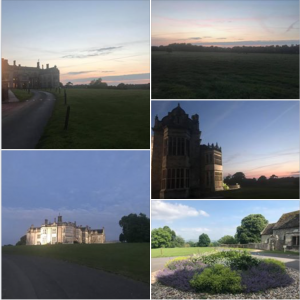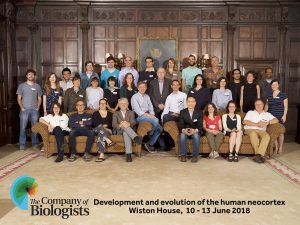Towards understanding the quirks of human brain evolution
Posted by hblockus, on 28 June 2018
In early June, a group of 30 world-leading experts came together thanks to an invitation by the Company of Biologists to Wiston House (Sussex, UK) to discuss our current understanding about evolutionary and molecular mechanisms that contributed to developing the specific qualities of our human brains.

Fortunately, the Company of Biologists offers fully funded participation for up to ten young career scientists to attend these workshops, and I had the honor to take part in this extraordinary event. The workshop excelled at what many conferences strive for, but only few achieve: open discussion of unpublished data and the big outstanding questions in the field. What I as a youngster appreciated most about the experience was the accepting atmosphere during discussions on- and offline, which was aided by the young participants being offered the same amount of time to present their work in talks as the senior scientists. This even playing field fueled optimism and inspiration for future cross-disciplinary collaborations. This was further facilitated by the workshop bringing together people working on many different aspects of human brain evolution and development: geneticists, to molecular and cellular biologists, behavioralists, anthropologists, mathematicians and engineers. All were united in the goal of understanding how our brain turned out to be so strikingly different, but also in some aspects so similar, when compared to other mammalian species.
I much appreciated the interspersed discussion sessions led by the three organizers, Arnold Kriegstein, Victor Borrell and Wieland Huttner, which pushed the leading edge of the field to inspire creative thoughts about new directions to take. The participants scratched their heads and engaged in lively discussions concerning some of the big new findings in the field and how to integrate those across scales of investigation from genetics to biophysical models and behavioral outcomes. For instance, we discussed the origin and implications of having a folded cortex with gyri and sulci, their variability and inheritance, whether or not cortical folding is “simply” an epiphenomenon that is only mechanically induced, and what the temporal relationship between folding and connectivity may be. Participants presented interesting data on model systems to approach these questions, including exciting work on brain diseases related to folding and ferrets as a suitable and tractable animal model of a folded brain. Relatedly, when it comes to recent technological advances concerning model systems for human brain development, organoids, three-dimensional cellular networks derived from human ES or induced pluripotent stem cells, are a highly intriguing opportunity that allows for genetic accessibility and experimental control recapitulating many of the early steps of in vivocortical development. It is certainly an exciting time for this technology, which has the potential to fruitfully contribute to our understanding of genetic and cellular events that shape early circuit formation in human neuronal networks.
Throughout the course of the workshop, a lot of emphasis was put on the unique proliferative events that allow for the human brain to accumulate its staggering number of neurons. In the closing discussion session, it was discussed that on top of the sheer number of neurons, it will be important to further our understanding of how different cell types with human-specific molecular signatures contribute to certain traits of the human brain. Relatedly, understanding how synapses and neuronal connectivity may have been shaped differently during human evolution will help our understanding of functional consequences of early developmental events thought to be unique to humans.

Altogether, I am tremendously grateful for having been given the opportunity to attend this workshop and follow the inspiring discussions that certainly broadened my perspective and gave a sense of where the field will move to in the years to come. Wiston House is an amazing place for an event like this, peaceful and remote, in a beautiful landscape that cannot help but inspire creative thinking and groundbreaking new collaborations through thought-sharing. I cannot thank the Company of Biologists, and Wiston House staff enough for providing this unexampled setting to answer unique questions about the mysteries of the past and present existence of our elusive human brains.


 (No Ratings Yet)
(No Ratings Yet)